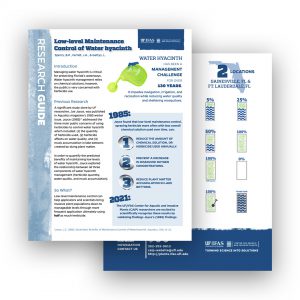In this study, research biologist Ben Sperry, professor Lyn Gettys, and center director and professor Jay Ferrell are replicating a significant study done by University of Florida researcher Joe Joyce that was published in the Aquatics magazine’s 1985 winter issue. Joyce found that low-level maintenance control, spraying herbicide more often with less overall chemical solution used over time, can reduce the amount of herbicide used annually, prevent decreased dissolved oxygen concentrations in the water, and reduce muck accumulation in lake bottoms. Sperry and Ferrell are using the same six treatment levels conducted by Joyce in 1985 along with two additional treatment levels.
So What?
Low-level maintenance control can help applicators and scientists bring invasive plant populations down to manageable levels through more frequent applications, ultimately using less herbicide over time while promoting native plant biodiversity.
To read or download this research guide, visit UF/IFAS CAIP’s Publications.
This research guide highlights:
-
-
- Water hyacinth is a rapidly growing invasive plant that has been a management challenge in Florida for over 130 years, and managing it is critical for protecting Florida’s waterways and human health.
- In 1985, UF researcher Joe Joyce published an article in Aquatics magazine about the benefits of low-level maintenance control: less herbicide used, increased water quality, and reduced muck accumulation.
- Today, Sperry and Ferrell are working to scientifically recognize those results.
-
What is a Research Guide?
The UF/IFAS Center for Aquatic and Invasive Plants (CAIP) is an internationally recognized multidisciplinary research, teaching, and extension unit known for having the most relevant information on invasive plant management. This one-of-a-kind Center focuses on developing and disseminating strategies for addressing the impact of invasive plants.
In an effort to share their findings, CAIP researchers and the communications team collaborate to translate scientific journal articles into simple, easy-to-understand research guides. These one-page research guides are simplified summaries about research projects happening at the Center. These are created to assist plant industry professionals and the public understand new scientific information quickly and easily.
Follow UF/IFAS CAIP on Facebook, Instagram, and Twitter. Read more blogs like this one on the UF/IFAS CAIP blog.
UF/IFAS Center for Aquatic and Invasive Plants. Turning Science Into Solutions.
 0
0
